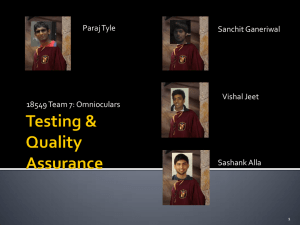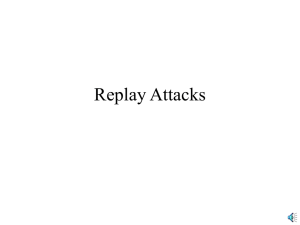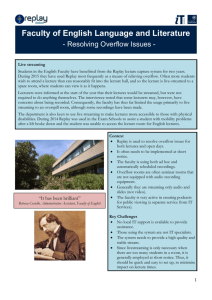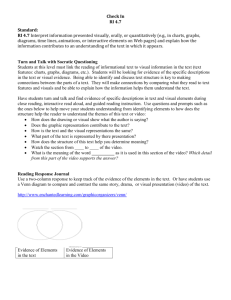Evaluating the Effectiveness of Derivation Replay in
advertisement
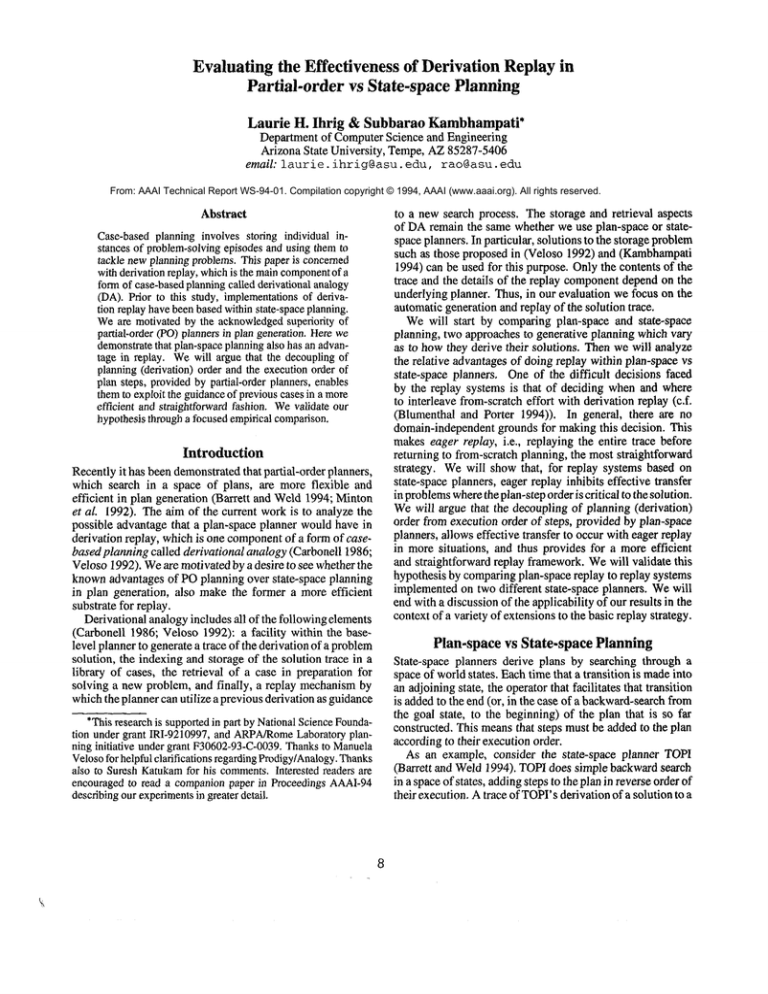
Evaluating the Effectiveness of Derivation Replayin
Partial-order vs State-space Planning
Laurie H. Ihrig & Subbarao Kambhampati*
Department of ComputerScience and Engineering
Arizona State University, Tempe, AZ85287-5406
email: laurie,ihrigOasu,edu, rao@asu,edu
From: AAAI Technical Report WS-94-01. Compilation copyright © 1994, AAAI (www.aaai.org). All rights reserved.
Abstract
Case-basedplanning involves storing individual instances of problem-solving
episodes and using themto
tackle newplanningproblems.This paper is concerned
with derivationreplay, whichis the maincomponent
of a
formof case-basedplanningcalled derivationalanalogy
(DA). Prior to this study, implementationsof derivation replay havebeenbasedwithin state-spaceplanning.
Weare motivated by the acknowledged
superiority of
partial-order (PO)plannersin plan generation.Here
demonstratethat plan-spaceplanningalso has an advantage in replay. Wewill argue that the decouplingof
planning(derivation) order and the executionorder
plan steps, providedby partial-order planners, enables
themto exploit the guidanceof previouscases in a more
efficient and straightforwardfashion. Wevalidate our
hypothesisthrougha focusedempiricalcomparison.
Introduction
Recentlyit has beendemonstratedthat partial-order planners,
which search in a space of plans, are more flexible and
efficient in plan generation (Barrett and Weld1994; Minton
et aL 1992). The aim of the current work is to analyze the
possible advantage that a plan-space planner would have in
derivation replay, whichis one componentof a form of casebased planning called derivational analogy (Carbonell 1986;
Veloso1992). Weare motivatedby a desire to see whether the
knownadvantages of POplanning over state-space planning
in plan generation, also make the former a more efficient
substrate for replay.
Derivational analogy includes all of the following elements
(Carbonell 1986; Veloso 1992): a facility within the baselevel plannerto generatea trace of the derivation of a problem
solution, the indexing and storage of the solution trace in a
library of cases, the retrieval of a case in preparation for
solving a new problem, and finally, a replay mechanismby
whichthe planner can utilize a previous derivation as guidance
to a new search process. The storage and retrieval aspects
of DAremain the same whether we use plan-space or statespace planners. In particular, solutions to the storage problem
such as those proposed in (Veloso 1992) and (Kambhampati
1994) can be used for this purpose. Only the contents of the
trace and the details of the replay componentdependon the
underlying planner. Thus, in our evaluation we focus on the
automaticgeneration and replay of the solution trace.
Wewill start by comparing plan-space and state-space
planning, two approaches to generative planning which vary
as to howthey derive their solutions. Thenwe will analyze
the relative advantages of doing replay within plan-space vs
state-space planners, One of the difficult decisions faced
by the replay systems is that of deciding when and where
to interleave from-scratcheffort with derivation replay (c.f.
(Blumenthal and Porter 1994)). In general, there are
domain-independentgrounds for makingthis decision. This
makeseager replay, i.e., replaying the entire trace before
returning to from-scratch planning, the most straightforward
strategy. Wewill showthat, for replay systems based on
state-space planners, eager replay inhibits effective transfer
in problemswherethe plan-steporder is critical to the solution.
Wewill argue that the decoupling of planning (derivation)
order from execution order of steps, provided by plan-space
planners, allows effective transfer to occur with eager replay
in more situations, and thus provides for a more efficient
and straightforward replay framework.Wewill validate this
hypothesis by comparingplan-space replay to replay systems
implementedon two different state-space planners. Wewill
end with a discussion of the applicability of our results in the
context of a variety of extensionsto the basic replay strategy.
Plan-space vs State-space Planning
State-space planners derive plans by searching through a
space of world states. Eachtime that a transition is madeinto
an adjoiningstate, the operator that facilitates that transition
is addedto the end (or, in the case of a backward-searchfrom
the goal state, to the beginning) of the plan that is so far
*Thisresearchis supportedin part by NationalScienceFounda- constructed. This meansthat steps must be addedto the plan
tion under grant IRI-9210997,and ARPA/Rome
Laboratory planning initiative undergrant F30602-93-C-0039.
Thanksto Manuela accordingto their executionorder.
As an example, consider the state-space planner TOPI
Velosofor helpful clarifications regardingProdigy/Analogy.
Thanks
(Barrett and Weld1994). TOP1does simple backwardsearch
a/so to SureshKatukam
for his comments.Interested readers are
encouragedto read a companionpaper in Proceedings AAAI-94 in a spaceof states, addingsteps to the plan in reverse order of
describingour experiments
in greaterdetail.
their execution. A trace of TOPI’sderivation of a solution to a
8
Goal : (AT-OBOB2AP1)
: ((IS-A AIRPORT
API) (IS-A AIRPORT
AP2))
(IS-A AIRPORTAP3) (AT-PL PLI AP3)
(AT-OBOB2 AP2) ...
Name: G 1
[ Name: G4
[
Type : ESTABLISHMENT
Type : START-NODE
Kind : NEW-STEP
Name: G2
Type : ESTABLISHMENT
NewStep: (LOAD-PLOB2 ’/PI ?A2)
Open Cond: ((INSIDE-PL OB2?PI)
Kind : NEW-STEP
New Step: CUNLOAD-PL
OB2 ?P1 API)
Name: G5
Type : ESTABLISHMENT
Open Con& ((AT-OB OB2 AP1) GOAL)
Kind : NEW-STEP
Name: O3
NewStep: ((FLY-PL?PI ?A3 ?A2)
Type : ESTABLISHMENT
Kind : NEW-STEP
OpenCond: ( (AT-PLPLI ?A2)
NewStep: (FLY-PL?P1 ?A2 API)
Keyto Abbreviations:
pL=PLANE,AP=AIRPORT,OB=OBJECT
Open Con& ((AT-PL ?P1 AP1)
Initial
Final Plan: (FLY-PLPL1AP3 AP2) Created
(LOAD-PLOB2 PL1 AP2) Created
(FLY-PL PLI AP2 AP1) Created
(UNLOAD-PL
OB2 PLI API) Created
Orderingof Steps: ((4 < 3) (3 < 2) (2
GOAL STATE
Figure 1: An ExampleSolution Trace for DerTOPI
Figure 2: MovingThroughState Space
problemfrom the logistics transportation domainof (Veloso
1992) is provided in Figure 1. This domain involves the
movementof packages across locations by various transport
devices. The trace corresponds to a simple problemin which
there is an airplane P1 at airport AP3,a packageOB2at airport
AP2,and the goal is to transport this packageto destination
AP1. Figure 2 shows graphically how TOPIwould derive a
plan for this problemby stepping through a sequenceof world
states, applyingan operator to the plan at each transition.
Plan-spaceplanners derive their plans by traversing a space
of partly-constructed plans. The plan-space planner moves
through this space by successively modifying the currently
active plan, starting with an emptyplan. Plans are refined
by adding constraints which include new steps as well as
new orderings between steps. Figure 4 provides a trace
of SNLP’sdecision process in arriving at a solution to our
example problem taken from the logistics domain. SNLP
(McAllester and Rosenblitt 1991; Barrett and Weld1994) is
causal-link partial-order planner. A path through plan-space
which corresponds to the derivation contained in Figure 4
is displayed graphically in Figure 3. This figure serves to
illustrate the POplanners’ least commitment
strategy whenit
comesto step-orderings. Orderings are added as required by
the subgoalingstructure, since steps that contribute conditions
must precede the steps that require these conditions. Steporderings are also added to resolve conflicts betweensteps,
for example, whenone step is deleting the contribution of
another. Notice in Figure 3 that this meansthat newsteps may
first be addedin parallel to an existing step sequence.Further
step orderings may then be added which accomplish the
interleaving of the newaction into the existing plan segment.
It is this ability to interleave newsteps into the plan which
gives the POplanner an advantage in replay.
Relative Advantagesof POvs. State-space
Planning in Supporting Replay
The previous section characterizes the differences between
the state-space and plan-space planning formalisms. In this
section, we will look at the ramifications of these differences
on the efficiency of replay.
ADD~P I
NULL IPLAN
Figure 3: MovingThrough Plan Space
As mentionedearlier, replay involves applying the decisions taken in a previous planningepisode to the context of a
new planning problem. Since the new problem maycontain
goals and initial conditions whichare different from that of
the previousone, it is likely that the result of replay is a plan
which only partially solves the newproblem. Thus, the plan
that is returned by the replay proceduremaystill contain open
conditions, either because a prior decision that was taken in
solving a subgoal is not valid in the newcontext, or because
there are top level goals that are not covered by the previous
trace. Suchpartial plans resulting from replay will then have
to be extended into a complete solution for the newproblem.
It is in this situation that the plan-spaceplanners showmore
flexibility over state-space planners.
In particular, as discussed in the previous section, planspace planners can extend a partial plan by interleaving steps
anywherein the plan. In contrast state-space planners can
only add steps to either the beginningor the end of the partial
plan. Thus, if the extra goals of the newproblemrequire steps
In particular, since the POplanners decouple derivation
(planning) order of plan steps from their execution order,
eager replay strategy will not mislead them as much.It is
therefore morelikely that all of the previous advice that is
applicable to the newproblemis fully utilized. This reasoning
leads us to believe that plan-spaceplannerswill exhibit greater
performance improvementsthrough replay when interacting
subgoalsmakestep order critical for a plan’s success. Thenext
section describes an empirical evaluation of this hypothesis.
Goal : (AT-OBOB2 AP1)
: ((IS-A AIRPORTAP1) (IS-A AIRPORTAP2))
(IS-A AIRPORTAP3) (AT-PL PLI AP3)
(AT-OBOB2AP2) ...
Name: GI
Name : G7
, Type : START-NODE
Type : ESTABLISHMENT
Name: G2
Kind : NEW-LINK
Type : ESTABLISHMENT
NewLink: (0 (IS-A AIRPORTAPI)
Kind : NEW-STEP
Open Cond: ((IS-A AIRPORT
AP1)
New Step: (UNLOAD-PLOB2 ?P1 API)
Name : G8
New Link: (1 (AT-OB OB2 API) GOAL)
q~pe : ESTABLISHMENT
Open Cond: ((AT-OB OB2 API) GOAL)
Kind : NEW-STEP
Name: G3
New Step: (LOAD-PLOB2 PLI ?A4)
Type : ESTABLISHMENT
NewLink: (4 (INSIDE-PL OB2PLI)
Open Con&((INSIDE-PL OB2 PLI)
Kind : NEW-STEP
NewStep: (FLY-PL ?PI ?A2 API)
Name : G9
NewLink: (2 (AT-PL?PI AP1)
Type : ESTABLISHMENT
OpenCond: ((AT-PL ?P1 AP1)
Kind : NEW-LINK
Name : G4
NewLink: (3 (AT-PLPLI AP2)
Type : ESTABLISHMENT
Open Cond: ((AT-PL PL1 ?A4)
Kind : NEW-STEP
Name : G10
New Step: (FLY-PL?P1 ?A3 ?A2)
Type : RESOLUTION
NewLink: (3 (AT-PL?PI ?A2)
Kind : PROMOTION
Open Cond: ((AT-PL ?PI ?A2)
Unsafe-link : ((3 (AT-PLPLI AP2)
Name : O5
2 (AT-PLPLI AP2))
Type : ESTABLISHMENT
Name: G11
Kind : NEW-LINK
Type : ESTABLISHMENT
NewLink: (0 (AT-PLPLI AP3)
Kind : NEW-LINK
Open Cond: ((AT-PL ?P1 ?A3)
NewLink: (0 (AT-OBOB2AP2)
Name : G6
Open Cond: ((AT-OBOB2 AP2)
Type : ESTABLISHMENT
Keyto Abbreviations
Kind : NEW-LINK
PL = PLANE
NewLink: (0 (1S-A AIRPORT
AP2)
AP = AIRPORT
Open Cond: ((IS-A AIRPORT
?A2)
OB = OBJECT
Initial
EmpiricalEvaluation
Final Plan: (FLY-PLPL1AP3 AP2) Created
(LOAD-PLOB2 PLI AP2) Created
(FLY-PL PL1 AP2 API) Created
(UNLOAD-PL
OB2 PL1 API) Created
Orderingof Steps: ((4 < 2) (3 < 4) (4 < 1) (3 < 2)
Figure 4: An ExampleSolution Trace for DerSNLP
that have to be interleaved into the plan produced through
replay, the POplanner is more likely than the state-space
planner to successfully extend the plan resulting from replay.
As an example,supposethat the trace containedin Figure 4
is replayed for the problemthat requires the additional goal,
(AT-OB
OB3AP1), and OB3is initially on the old route taken
by the airplane. Notice that the optimal wayof dealing with
the extra goal requires interleaving two steps -- to load OB3
into the plane and unload it from the plane -- at appropriate
places into the current plan. Replay systems based on a
partial-order planner such as SNLPcan accomplish this by
first addingthe steps in parallel to the existing steps, and then
ordering themwith respect to other steps in the process of
resolving conflicts.
This interleaving of newsteps is not possible if replay is
based on state-space planners since they can extend a partial
plan only by adding steps to the beginning or end. In this
particular example, the state-space planners can extend the
partial plan to deal with the additional goal, but do so by
makingthe plane return to pick up the second package and
then deliver it, thus resulting in a less optimal solution. In
other cases, the inability to interleave the plan maymakethe
state-space planner backtrack over the partial plan resulting
from replay (This will happen, for example, whensolving
problems from the ART-MD-NS
domain described below).
To summarize, when replay is based on a state-space
planner and step order is critical for the success of the plan,
eager replay maynot allow for effective transfer. Partialorder plan-space planners do not suffer from this problem.
10
Anempirical analysis was conductedin order to test our hypothesis regarding the relative effectiveness of eager replay
for POplanners. For a more detailed description of these
experiments, see (Ihrig and Kambhampati1994). Weimplementedan eager-replay strategy on the state-space planner,
TOPI (DerTOPI), and the plan-space planner SNLP(DerSNLP).Withthis strategy, the search process is interrupted
to replay the entire derivation trace before returning to fromscratch planning. Wealso implemented eager replay on
a second state-space planner, NOLIMIT,
since it recently
served as a substrate for a comprehensivederivational analogy system (Veloso 1992). Although NOLIMIT
differs from
TOPIin several respectsI , it is also a state-space planner in
the sense that it extendsa current partial plan by addingsteps
to the end of the plan. To facilitate fair comparisons,the
three planning methods, SNLP, TOPI, and NOLIMIT,were
(re)implementedon the same substrate.
ART-MD-NS
Domain: Experiments were run on problems
drawnfrom two domains.The first was the artificial domain,
ART-MD-NS,
originally described in (Barrett and Weld
1994) and shownin the table below:
ART-MD-NS
(D’~ S2):
A~precond: I~ add, : Pi delete : {Ijlj < i})
A~p~eeo~d
:P~~dd
:C,delete
:{IjlVj}
0{PJlJ<q)
Conjunctivegoals from this domainare nonserializable in
that they cannot be achieved without interleaving subplansfor
the individual conjuncts. For example, consider the problem
that contains the conjunctive goal G1 A G2. The subplan for
achieving this goal would be: A~ ~ A~ --* Al2 ~ A2. This
plan has to be interleaved with steps to solve the additional
goal G3. The plan for the newconjunctive goal GI A 6/2 A O3
l ~ A 2--~ A2--+ A2
is AI ._L,A21 -+ A_/3
l
2 3.
Logistics TransportationDomain:The logistics transportation domainof (Veloso 1992) was adopted for the second set
of experiments.Initial conditions of each problemrepresented
the location of various transport devices (one airplane and
three trucks) over three cities, each city containingan airport
and a post office. Four packages were randomlydistributed
INOLIMIT is a means-endsanalysis planner like PRODIGY
and STRIPS,
attemptinggoals by backward-chaining
from the goal
state. Applicableoperators(operatorswhosepreconditionsare true
in the currentstate) are addedto the endof the plan andthe current
state is advancedappropriately. Unlike STRIPS,NOLIMIT
can
defer step additionin favorof further subgoaling.It doesthis by
addingrelevantoperatorsto a list of potentialoperatorsbeforeactual
placement
in the plan.
Phase
OneGoal
%Solved
nodes
time(sec)
TwoGoal
% Solved
nodes
time(sec)
ThreeGoal
%Solved
nodes
time(sec)
Four Goal
%Solved
nodes
time(see)
ART-MD-NS
(depth-first, CPUlimit: lOOsec)
DerSNLP
DerTOP1
DerNOLIMIT
replay scratch replay scratch replay scratch
Logistics(best-first, CPU
limit: 550sec)
DerSNLP
DerTOPI
replay
scratch
replay
scratch
100%
30
.73
100%
90
.68
100%
30
.45
100%
60
.47
100%
30
.63
100%
120
2.5
100%(3.5)
617
15
100%(3.5)
946
19
100%(5.0)
46
11
100%(3.5)
507
49
100%
257
2
100%
317
2
100%
180
5
100%
184
4
100%
347
8
100%
296
12
100%(5.8)
1571
50
100%(5.8)
2371
51
97%(6.2)
15824
6216
63%(5.6)
8463
3999
100%
395
7
100%
679
4
100%
549
16
100%
462
11
100%
1132
34
100%
662
34
100%(7.9)
6086
230
100%(7.9)
7400
262
0%
0%
100%
577
35
100%
1204
43
100%
1715
227
100%
1310
96
100%
5324
368
100%
1533
100
lOO%
(10.0)
9864
497
100%(lO.O)
24412
1264
0%
0%
Table 1: Performancestatistics in ART-MD-NS
and Logistics Transportation Domain(Average solution length is shownin
parentheses next to %Solvedfor the logistics domainonly)
over airports. So as to makestep order critical, problemswere
chosen from this domainto contain subgoals that interact.
Problemsrepresent the task of getting one or more packages
to a single designatedairport.
Whereas each problem in ART-MD-NS
has a unique solution, in the logistics domainthere are manypossible solutions
varying in length. However,optimal (shortest) solutions can
only be found by interleaving plans for individual goals. This
difference has an important ramification on the wayeager replay misleads state-space planners in these domains.Specifically, in the ART-MD-NS
domain, state-space planners will
have to necessarily backtrack from the path prescribed by eager replay to find a solution. In the logistics domain,they can
sometimesavoid backtracking by continuing in the replayed
path, but will find inoptimal plans in such cases.
Results
The results of testing are shownin Table 1. Eachtable entry
represents cumulative results obtained from a sequence of 30
problemscorrespondingto one phase of the run. Problemsize
was increased by one goal for each phase. A library of cases
was formed over the entire run. Each time a problem was
attempted, the library was searched for a previous case that
was similar (See (Ihrig and Kambhampati
1994)). If one
found, the new problem was run both in scratch and replay
mode,and the problembecamepart of the 30 problemset for
that phase. If there was no previous case that applied, the
problemwas merely added to the library.
The first row of Table 1 showsthe percentage of problems
correctly solved within the time limit. The average solution length is shownin parentheses for the logistics domain
(Solution length was omitted in ART-MD-NS
since all the
problems have unique solutions.) The subsequent rows of
Table 1 contain the total numberof search nodes visited for
all of the 30 test problems,and the total CPUtime. DerSNLP
was able to solve as manyor moreof the multi-goal problems
than the two state-space planners both in from-scratch and
replay modes, and did so in less time. Our implementation
of DerNOLIMIT
was not able to solve any of the multi-goal
problems in the logistics domainwithin the time limit, and
this columnis therefore omitted from the table.
In the ART-MD-NS
domain, replay resulted in performance improvements for DerSNLPwhich increased with
problem size (See Table 1). Comparative improvementswith
replay were not found for the two state-space planners in
the multi-goal phases. In the logistics domain, not only did
DerTOPIfall to improveperformancethrough replay, it also
experienced an increase in average solution length. In contrast, replay in DerSNLPled to performance improvements
(without increasing the solution length). These results are
consistent with our hypothesisthat state-space planners will
be misled by eager replay whenstep order is critical.
Analyzing the Generality
Results
of Experimental
The experiments reported in this paper concentrated on the
relative effectiveness of state-space and plan-space planners
in supporting eager replay. Someimplementedreplay systems, such as REMAID
(Blumenthal and Porter 1994) and
PRODIGY/ANALOGY
(Veloso 1992) utilize more complex
forms of replay strategies to support derivational analogy.
This raises a question as to the applicability of our experimental results to such frameworks.Wewill address this issue
below.
InterruptingReplay: Somereplay systems interrupt replay
of the trace to interleave from-scratcheffort (e.g. (Blumenthal
and Porter 1994)). It wouldseemas if such strategies could
offset the inflexibility of state-space planners in replaying
cases whenstep order is critical. Consideragain our example
problem from the logistics domain. Recall that we have
a plan that corresponds to transporting a single packageto
a designated airport, and the new situation requires us to
transport another packageto the samedestination, and this
package lies somewherealong the plane’s route. One way
someobservations about the apparent disparity between our
results and the previous work on DArooted in state-space
a state-space planner can produce an optimal plan without
planning which has demonstrated significant performance
backtrackingoverthe result of replay is to interrupt the replay
improvements with replay (Veloso 1992). Webelieve the
in the middle, do from-scratch planning to deal with the
mainreason for this maybe the strong presenceof interacting
additional goal, and resume replay. However,the optimal
point in the derivation for inserting the newsteps depends
goals in our multi-goal problems,coupledwith the fact that we
used vanilla planning algorithms without any sophisticated
on the problem description, since it will depend on where
the new packageis located on the old route. The early work backtracking strategies or pruning techniques. Although
these techniques mayimprovethe performanceof state-space
on derivation replay that is rooted in state-space planning
has thus been forced to focus a good deal of attention on
planners, these will be of benefit to POplanners as well.
Moreover,we have shownthat the shift to plan-space replay
the problemof determining whento plan for additional goals
lessens the need for backtrackingover the replayed path.
(Blumenthal and Porter 1994). In general, there are
Finally, our results from experimentsin the logistics dodomain-independent grounds for deciding when and where
mainindicate that even partial-order planners maybe misled
the from-scratch problem-solvingeffort should be interleaved
by eager replay in some instances. This happens when the
with replay. This leaves the planner with heuristic guesses,
previous case may have achieved one of the goals using
whichmayturn out to be incorrect, leading to backtracking
somestep sl and the new problem contains a goal On which
once again. In contrast, as we have shown, the partialcannot be achieved in the presence of sl. However,in such
order planner can exploit the previous case with eager replay
without the need to interrupt replay of the trace.
cases, state-space planners will also be misdirected. Thusour
hypothesisis only that plan-spaceplanners are less likely to
Multi-pass Replay: Other replay systems, such as
be misled (and thus morelikely to exploit the previous case)
PRODIGY/ANALOGY
use a multi-pass strategy in replay.
through eager replay.
Rather than abandonthe case after it has been replayed once,
such systems keep the case and replay it again as necesSummary
sary whenthe plan that resulted from replaying that case is
backtracked over. This too could sometimeshelp state-space
In this paper, we described the differences between planplannersin improvingtheir ability to exploit a previous trace.
space and state-space approaches to planning. Wedeveloped
In our exampleabove, this will involve replaying the old trace
a testable hypothesis regarding the relative advantage of
once, and whenthe planner fails to extend it to deal with the
plan-space planning over state-space planning in derivation
newgoal, backtracking, workingon the extra goal, and then
replay. Wesupported this hypothesis with the help of a
replaying the case again. Veloso (Veloso 1992) discusses
focused empirical study. Wethen discussed the generality
an interesting mechanismfor keeping track of the extent to
and applicability of our hypothesisin the context of a variety
which the case has been replayed, and movingthe pointer up
of extensionsto the basic replay strategy.
appropriately wheneverbacktracking occurs.
Althoughthis is an intuitively appealing idea (and could
References
in fact be adapted to replay systems based on any planning
Barrett, A. andWeld,D. 1994.Partial order planning:evaluating
framework), it is not guaranteed to completely overcomethe
possibleefficiencegains. Artificial Intelligence67(1).
inflexibility of state-space planners in replay. In particular,
Blumenthal,
B. andPorter, B. 1994.Analysisand empiricalstudies
unless the planner has domainspecific control information,
of derivationalanalogy.Artificial Intelligence.Forthcoming.
it maybe forced to backtrack manytimes before finding the
Carbonell, J. 1986. Derivational analogy: A theory of reconright place to insert the steps correspondingto the newgoals.
structive problemsolvingandexpertiseacquisition. In Michalski,
Wethus believe that while the multi-pass replay heuristic may
Ryszard;Carbonell,Jaime; and Mitchell, TomM., editors 1986,
sometimesimprovethe effectiveness of replay in state-space
Machine
Learning:an Artificial Intelligence approach:Volume2.
planning, it still does not eliminate the essential advantages
Morgan-Kaufman.
of plan-space planners in supporting reuse.
Ihrig, L. andKambhampati,
S. 1994.Derivationreplayfor partialMulti-case Replay: A feature of PRODIGY/ANALOGY
is
order planning. In ProceedingsAAAl--94.
its ability to use multiple cases in guiding replay. Although
Kambhampati,
S. 1994. Exploiting causal structure to control
our empirical study involved only replay of a single case
retrieval andrefitting duringplanreuse. Computational
Intelligence
for each problem, we believe that the results can also be
Journal10(2).
extended to multi-case replay. Whenwe have multiple cases,
McAllester, D. and Rosenblitt, D 1991. Systematic nonlinear
in addition to the decision as to howto interleave replay with
planning. In ProceedingsAAAI-91.
634--639.
from-scratch planning, we also have the decision as to how
Minton,S.; Drummond,
M.; Bresina,J.; andPhifips, A 1992.Total
to interleave the replay of the individual cases. Whenstep
order vs partial order planning:factors influencingperformance.
order is critical, the state-space planner will haveto attempt
In ProceedingsKR-92.
both types of interleaving to successfully exploit the guidance
Veloso, M. 1992. Learningby analogical reasoningin general
of previous cases. Onceagain, the plan-space planner will
problemsolving. Ph.D.Dissertation, Carnegie-Mellon
University.
have less need to do either of these, and can thus not only
replay the cases in any order, but also employeager replay on
individual cases.
Before concluding this section, we would like to make
12

